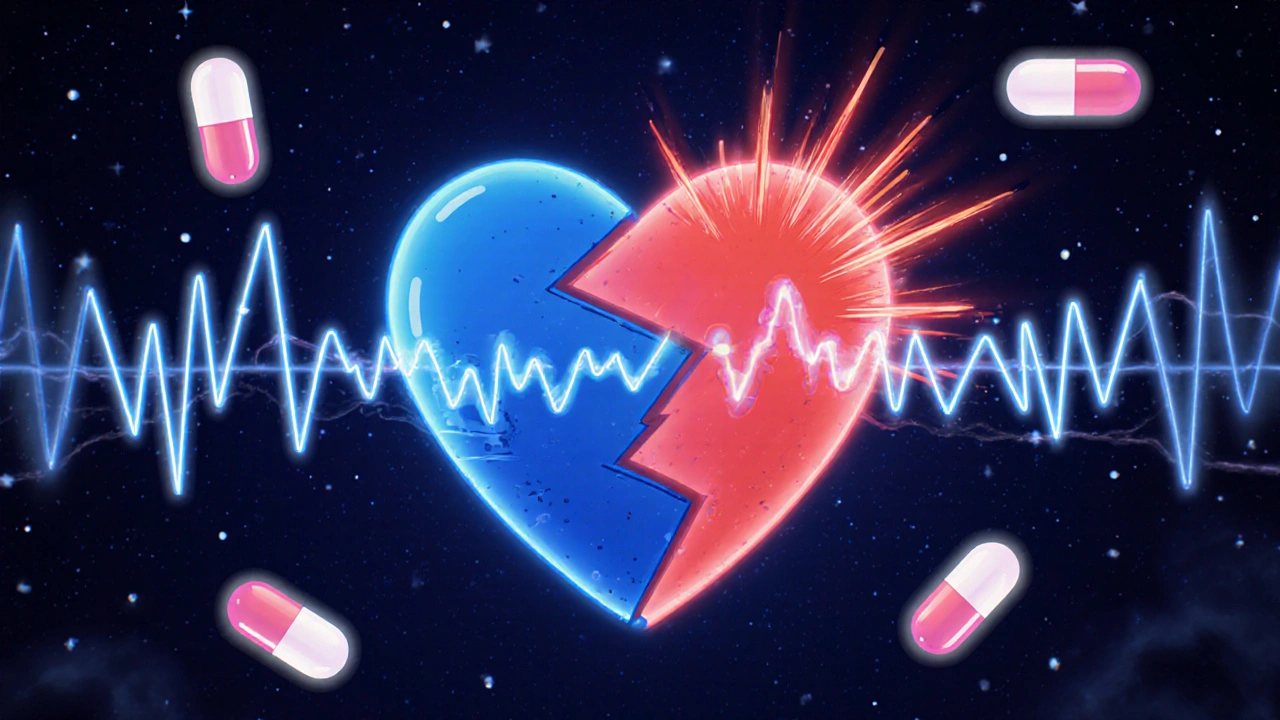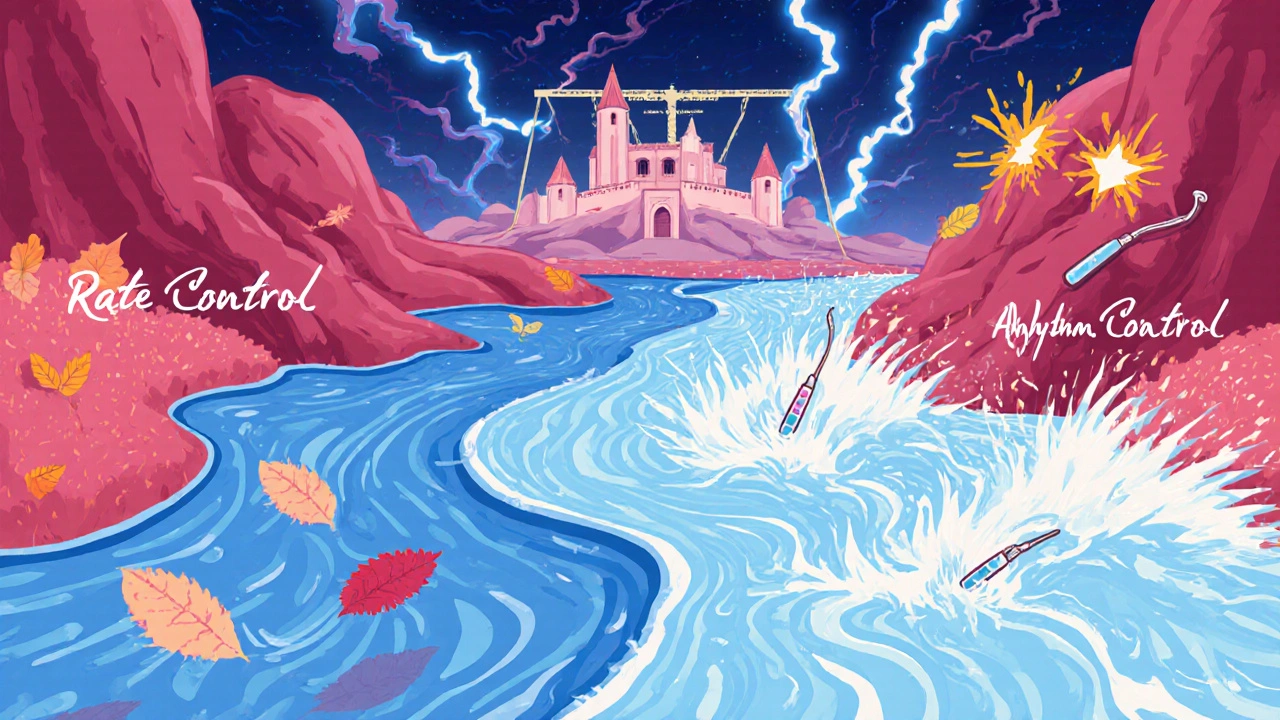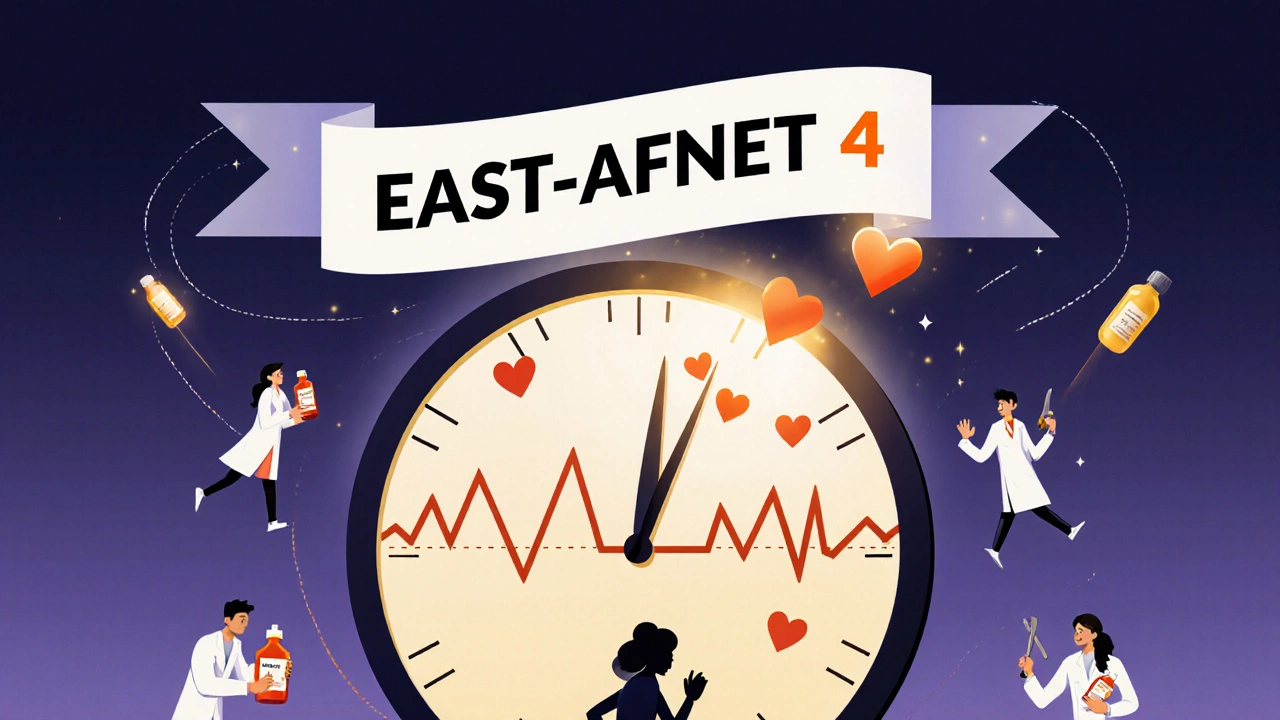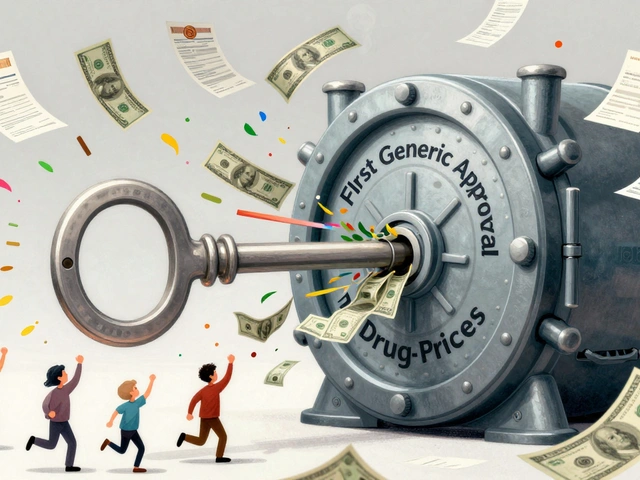
When your heart skips, races, or feels like it’s fluttering in your chest, it’s not just uncomfortable-it can be dangerous. Atrial fibrillation (AFib) is the most common type of irregular heartbeat, affecting millions worldwide. Left unchecked, it raises your risk of stroke by up to five times and increases your chance of dying from heart-related causes. But here’s the thing: treating AFib isn’t one-size-fits-all. Two main strategies exist-rate control and rhythm control-and both are tied to one critical goal: preventing stroke. So which approach is right for you? And why has the medical world started changing its mind about what works best?
What Is Rate Control?
Rate control means letting your heart stay in AFib but slowing down how fast it beats. The goal isn’t to fix the rhythm-it’s to keep your heart from racing too hard. Doctors aim to keep your resting heart rate under 110 beats per minute. You might think, "Why not try to fix it?" But sometimes, keeping things steady is safer than trying to reset them.The RACE II trial showed that a lenient approach-keeping your heart rate below 110 bpm-is just as good as a strict one (under 80 bpm) when it comes to preventing hospital visits, heart failure, or death. That’s good news because it makes treatment simpler. You don’t need constant monitoring or tight dose adjustments.
Common meds for rate control include:
- Beta-blockers like metoprolol or atenolol-these slow your heart and lower blood pressure.
- Calcium channel blockers like diltiazem or verapamil-great for short-term control, especially in the ER.
- Digoxin-often used in older patients or those with heart failure, though it’s slower and less effective than other options.
One 2022 study found amiodarone works faster and better than digoxin in emergency AFib cases. But even with these drugs, you still need blood thinners. Why? Because AFib lets blood pool in the heart, forming clots. Those clots can travel to your brain and cause a stroke-no matter if your heart rate is controlled or not.
What Is Rhythm Control?
Rhythm control is the opposite: try to get your heart back into a normal rhythm and keep it there. This might sound ideal-why live with an irregular heartbeat if you can fix it? But it’s not simple. It often involves stronger medications, procedures, or both.Drugs used for rhythm control include:
- Amiodarone-very effective but has serious long-term side effects like lung and thyroid damage.
- Flecainide and propafenone-safe for younger patients without heart disease.
- Dronedarone-a safer alternative to amiodarone, but not for people with severe heart failure.
Procedures include:
- Electrical cardioversion-a quick electric shock to reset your rhythm. Usually done under sedation.
- Catheter ablation-a minimally invasive procedure where doctors burn or freeze small areas of heart tissue causing the misfires. Complication rates have dropped from over 20% in the early 2000s to under 5% today.
Early rhythm control isn’t just for people with bad symptoms anymore. The landmark EAST-AFNET 4 trial in 2020 followed nearly 2,800 patients diagnosed with AFib within the last year. Those who got early rhythm control-either with drugs or ablation-had a 21% lower risk of dying, having a stroke, being hospitalized for heart failure, or having a heart attack over five years. That’s a big deal.
Stroke Prevention: The Non-Negotiable
No matter which path you take-rate or rhythm control-you still need anticoagulation. That’s the key point many patients miss. Even if your heart feels fine, if you have AFib, you’re still at risk for clots.Doctors use the CHA₂DS₂-VASc score to figure out your stroke risk. Points are added for things like age over 75, high blood pressure, diabetes, prior stroke, or heart failure. If your score is 2 or higher, you’re strongly advised to take a blood thinner.
Modern options like apixaban, rivaroxaban, or dabigatran are easier to use than old-school warfarin. No more weekly blood tests. They’re just as good-or better-at preventing strokes and carry less risk of dangerous bleeding.
The AFFIRM trial showed most strokes happened when patients stopped their blood thinners or didn’t keep their INR levels in range. That’s why consistency matters more than rhythm. Even if you’re in normal rhythm after an ablation, if your stroke risk is high, you’ll likely still need anticoagulants long-term.

Who Gets Rate Control? Who Gets Rhythm Control?
There’s no universal rule, but here’s how doctors are thinking today:Rate control is often first-line for:
- People over 75
- Those with multiple health problems (like kidney disease or COPD)
- Patients with no or mild symptoms
- People whose AFib is likely to come back no matter what
It’s simpler, safer, and avoids the risks of strong antiarrhythmic drugs. If you’re not bothered by your AFib and your heart isn’t racing too fast, this might be the best choice.
Rhythm control is now recommended earlier for:
- People under 65
- Those with paroxysmal AFib (comes and goes)
- Patients with heart failure or reduced heart function
- Anyone with a CHA₂DS₂-VASc score of 2 or higher
- People whose symptoms don’t improve with rate control
The 2023 European Society of Cardiology guidelines now say: "Early rhythm control should be offered to patients with AFib regardless of symptom severity." That’s a huge shift from just five years ago.
Why? Because newer ablation techniques work better, and newer drugs like dronedarone are safer. A 2023 review in the Cleveland Clinic Journal of Medicine pointed out that earlier trials like AFFIRM studied mostly older patients-70 on average. The results don’t always apply to younger, healthier people who might benefit more from getting back to normal rhythm.
Why the Change? The Science Has Evolved
In the early 2000s, the AFFIRM trial said rate control was just as good as rhythm control for survival. That shaped guidelines for nearly two decades. But those trials didn’t have today’s tools. Catheter ablation back then was risky and less effective. Antiarrhythmic drugs had more side effects. Patients weren’t treated early.The EAST-AFNET 4 trial changed everything. It proved that treating AFib early-within a year of diagnosis-with rhythm control leads to fewer deaths, strokes, and hospital stays. It wasn’t just about feeling better. It was about living longer.
Today, ablation success rates are higher. Complications are rarer. Drugs like dronedarone and flecainide are better understood. We now know that AFib isn’t just a rhythm problem-it’s a progressive disease. The longer it goes untreated, the more your heart changes, and the harder it becomes to fix.
Think of it like high blood pressure. You don’t wait until you have a heart attack to start treatment. Same here. Early action matters.
What About Quality of Life?
Some people think rhythm control is only about survival. But for many, it’s about feeling normal again. AFib can cause fatigue, shortness of breath, dizziness, and anxiety. Even if your heart rate is controlled, you might still feel awful.Studies show that patients who regain and keep a normal rhythm often report better energy, less shortness of breath, and improved sleep. That’s huge for daily life. If you’re active, work long hours, or care for family, feeling like yourself again isn’t a luxury-it’s essential.
One 2022 study in the Get With The Guidelines registry found that older adults (65+) with AFib and preserved heart function lived longer with rhythm control. That’s important because we used to think older patients couldn’t benefit.

What’s Next?
The future of AFib treatment is personal. Not everyone needs ablation. Not everyone needs strong drugs. But the idea that "just control the rate and call it good" is fading.Trials like ASSERT II are now looking at whether early ablation helps people with AFib and heart failure with preserved ejection fraction-a group that was previously thought to benefit little from rhythm control. Results are expected in 2025.
Meanwhile, wearable tech like smartwatches can now detect AFib early. That means more people are being diagnosed sooner-right when rhythm control has the best chance to work.
For many, the path forward looks like this: start with rate control and anticoagulation. But if symptoms persist, or if you’re younger and healthy, don’t wait. Talk to a cardiologist about rhythm control options. Early action isn’t risky-it’s the smartest way to protect your heart and your future.
Key Takeaways
- Both rate and rhythm control require lifelong anticoagulation to prevent stroke-no exceptions.
- Rate control is simpler and safer for older patients or those with many health issues.
- Rhythm control is now recommended earlier, especially for those under 75, with symptoms, or high stroke risk.
- Modern ablation is safer and more effective than ever, with complication rates below 5%.
- The EAST-AFNET 4 trial proved early rhythm control reduces death, stroke, and hospitalization by 21%.
Is rate control enough if I don’t feel symptoms?
Yes, if you’re older or have other health conditions, rate control is often the best choice-even without symptoms. But you still need blood thinners. The absence of symptoms doesn’t mean low stroke risk. Always check your CHA₂DS₂-VASc score with your doctor.
Can I stop blood thinners after an ablation?
Usually not. Even if your heart is back in rhythm, your stroke risk from AFib doesn’t disappear overnight. Guidelines recommend continuing anticoagulation for at least 2 months after ablation, and often longer if your CHA₂DS₂-VASc score is 2 or higher. Never stop without consulting your doctor.
Which is safer: amiodarone or ablation?
Ablation is generally safer long-term. Amiodarone is very effective but can damage your lungs, liver, or thyroid over time. Ablation has a small upfront risk (under 5%), but once successful, it often eliminates the need for long-term drugs. For younger, healthier patients, ablation is often preferred.
Do I need a specialist for rhythm control?
Yes. Rhythm control-especially ablation-requires a cardiac electrophysiologist. Not all cardiologists do this. Ask your doctor for a referral to a specialist with experience in AFib ablation. Access varies by region, so don’t delay if you’re a candidate.
Can I still exercise with AFib on rate control?
Absolutely. Rate control doesn’t mean you’re stuck. Many people on beta-blockers or diltiazem can exercise normally. Your doctor may adjust your dose to let your heart respond naturally during activity. Avoid pushing yourself to extremes until your heart rate is stable. Regular movement helps your heart health overall.
What to Do Next
If you’ve been diagnosed with AFib, don’t assume one treatment fits all. Ask your doctor:- What’s my CHA₂DS₂-VASc score? Am I at high stroke risk?
- Am I a candidate for early rhythm control?
- Have I been evaluated for ablation?
- What are my options if medications aren’t working?
- Can I get a referral to an electrophysiologist?
AFib is manageable. But the window for the best outcomes is often early. Waiting too long can make things harder. The goal isn’t just to survive-it’s to live well, with a steady heart and peace of mind.






12 Comments
Been on beta-blockers for AFib for 3 years. Still get dizzy if I climb stairs, but at least I haven’t had a stroke. Blood thinners are the real MVP here.
/p>I used to think if I didn’t feel it, it wasn’t happening. Then I had a mini-stroke at 52 and learned the hard way that AFib doesn’t care how you feel. My CHA₂DS₂-VASc score is 5. I’m on apixaban, and honestly? I don’t even remember what my heart feels like anymore. Just glad I’m still here. If you’re reading this and you’ve been told "it’s not that bad," don’t listen. It’s always that bad.
/p>My mom had AFib and refused anticoagulants because she "didn’t want to bleed." She had a massive stroke two months later. Don’t be her. Please.
OMG I just saw a TikTok about this and now I’m convinced everyone’s being lied to by Big Pharma 🤯 They’re making us take blood thinners so we’ll need more meds later for the side effects. It’s a trap!! I’m going to try garlic and apple cider vinegar instead. 🍎🧄 #AFibHack
/p>Let’s be real - the whole rate vs. rhythm debate is just medicine playing whack-a-mole with symptoms while ignoring the real issue: we treat AFib like it’s a standalone problem, not the canary in the coal mine for systemic inflammation, sleep apnea, and metabolic syndrome.
/p>People think popping a pill is the solution, but if you’re still eating processed junk, sleeping 4 hours a night, and stress-lifting your kids like they’re dumbbells, no ablation or amiodarone is going to fix that.
The EAST-AFNET 4 trial didn’t just prove rhythm control works - it proved that early intervention in people who actually care about their health works. The rest? They’re just delaying the inevitable.
Also, dronedarone isn’t "safer." It’s just less toxic than amiodarone. Both are still nuclear options. Ablation? Now that’s a real conversation - if your electrophysiologist isn’t doing 50+ cases a year, you’re playing Russian roulette with your heart.
They’re hiding something. Why do all the guidelines suddenly change after 2020? Coincidence? I looked up the funding for EAST-AFNET 4 - guess who paid for it? Medtronic. And now they’re pushing ablation like it’s the new iPhone. They don’t care if you live - they care if you buy the device. Wake up people. Your heart is a battery. Don’t let them zap it.
/p>My cardiologist in Vancouver said I’m a perfect candidate for ablation - under 65, paroxysmal AFib, score of 3. We’re scheduling it next month. Honestly? I’m terrified but also kinda excited. Feels like finally doing something proactive instead of just waiting to die.
/p>In India, we don’t have access to all this fancy stuff. We take amiodarone because it’s cheap and works. If you can’t afford ablation, don’t cry. Just take your pills. And yes, you still need blood thinners. No excuses. Your life is worth more than your pride.
/p>My brother got ablated last year. He’s back to hiking, playing guitar, sleeping through the night. No meds except a baby aspirin. I asked him if he regrets it. He said "No, but I wish I’d done it 5 years ago." That’s the real takeaway. Don’t wait until you’re 70 and wheezing.
/p>just wanted to say thank you for this post. i was diagnosed last year and felt so lost. i thought if i didn't feel bad then i didn't need to do anything. now i know better. i got my cha2ds2-vasc score done and its a 4. started apixaban and seeing a specialist next week. thank you for making it clear.
/p>Oh sweet Jesus, another one of these "I’m gonna ablate my way to enlightenment" posts. You people are ridiculous. You think ablation is a magic wand? It’s not. It’s a scalpel in a meat grinder. 5% complication rate? That’s 1 in 20 people getting a punctured heart, a stroke, or a collapsed lung. And then what? You still need anticoagulants. So what did you even gain? Just a bigger scar and a bigger bill. And don’t get me started on the 30% recurrence rate. You’re not fixing AFib - you’re just gambling with your innards. Go eat kale and stop letting corporations sell you false hope.
/p>They told me to take warfarin. I said no. I took turmeric. Then I had a stroke. Now I’m on apixaban. But guess what? I still don’t trust them. They’re lying about everything. They said AFib was harmless. They said blood thinners were safe. They said ablation works. All lies. I’m not taking anything anymore. I’m going to live on vibes and prayer. My heart knows what it’s doing. It’s not broken - it’s just angry at this world.
/p>I think the real question isn’t rate vs rhythm - it’s whether we’re treating AFib as a disease or a symptom. We fix the rhythm but ignore the root causes: obesity, sleep apnea, alcohol, chronic stress. I’ve seen patients get ablated, go back to their 3-pints-a-night routine, and be back in AFib within months.
/p>Maybe the real treatment isn’t a catheter or a pill - it’s a lifestyle overhaul. Maybe the medical system is too focused on procedures because they’re profitable. Maybe we need to stop treating hearts like machines and start treating people like whole beings.
I’m not saying don’t ablate. I’m saying don’t stop there. Your heart is a reflection of your life. Fix the life first. The rhythm will follow.